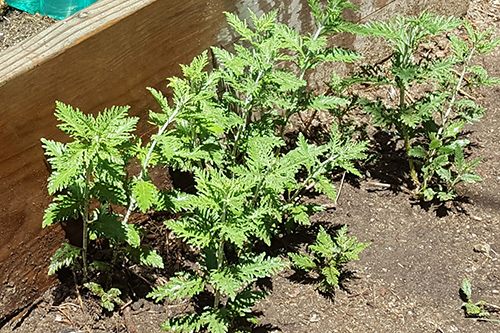 A weed is defined as a plant that grows where it isn’t wanted. Gardeners tend to recognize what wasn’t planted on purpose, including many of our nuisance weeds, such as redroot pigweed and common lambsquarters. But, what about unwanted seedlings from desirable plants that went to seed last year? You may see the herbs you planted last year pop up where you intend to plant your tomatoes, squashes or onions.
A weed is defined as a plant that grows where it isn’t wanted. Gardeners tend to recognize what wasn’t planted on purpose, including many of our nuisance weeds, such as redroot pigweed and common lambsquarters. But, what about unwanted seedlings from desirable plants that went to seed last year? You may see the herbs you planted last year pop up where you intend to plant your tomatoes, squashes or onions.
Unwanted plants in a vegetable and herb garden compete with desirable plants for moisture and nutrients. Due to prolific seeding and creeping roots, they can get out of hand fast if not controlled. Some desirable plants that can spread and become undesirable include borage, amaranth, chamomile, lemon balm and mint varieties.
Annual plants can be easily controlled by removing the flowers before they drop seed. Borage, amaranth and chamomile are herbs grown to harvest the leaves and flowers. If you didn’t harvest all the flowers and let one of these go to seed last year, you will probably find seedlings popping up in your vegetable garden in unwanted places.
Identifying seedlings can be tough, but for annual weeds, this is the best time for mechanical control. The first leaves, called seed leaves, of borage and chamomile seedlings are green and oval with smooth edges, but the first true leaves are very different. Borage seedlings have wrinkly, oval-shaped leaves; chamomile seedlings have thin, fleshy, deeply-lobed leaves.
Amaranth comes from a family of weeds that includes redroot pigweed, so the seedlings of each resemble one another. Depending on the variety of amaranth, the seedlings may be red or green, with red or green egg-shaped leaves. Redroot pigweed seedlings will have a distinct red root, and the underside of the leaves will be red too.
 Lemon balm and mint are two perennial herbs you may have in your garden. Lemon balm spreads by seed. The best way to stop a seedbank from forming is to remove the flower stalks when they form. If you forgot to do this last year, you may see the seedlings popping up now. Lemon balm seedlings have scalloped-edged leaves and are often round in shape.
Lemon balm and mint are two perennial herbs you may have in your garden. Lemon balm spreads by seed. The best way to stop a seedbank from forming is to remove the flower stalks when they form. If you forgot to do this last year, you may see the seedlings popping up now. Lemon balm seedlings have scalloped-edged leaves and are often round in shape.
Mint is much harder than lemon balm to get rid of. If you planted mint in a garden bed, you may want to relocate it to a container used for just mint. Mint spreads by underground rhizomes and has a vigorous growth habit. It can take over gardens easily when left unchecked. To get rid of unwanted mint plants, you will not only need to pull the plant, but also dig into the soil and remove the entire root system.
While you are looking for these unwanted plants, keep your eye out for summer annual weeds, such as common mallow, common purslane and redroot pigweed. If you have winter annual weeds that already went to seed, remove the plants and use prevention techniques to reduce germination of dropped seed this fall. These include mulching, cover cropping or growing other desirable vegetation in your garden beds to outcompete them.
Fisher, J.
2018,
Common herbs can become weeds,
Reno Gazette Journal


